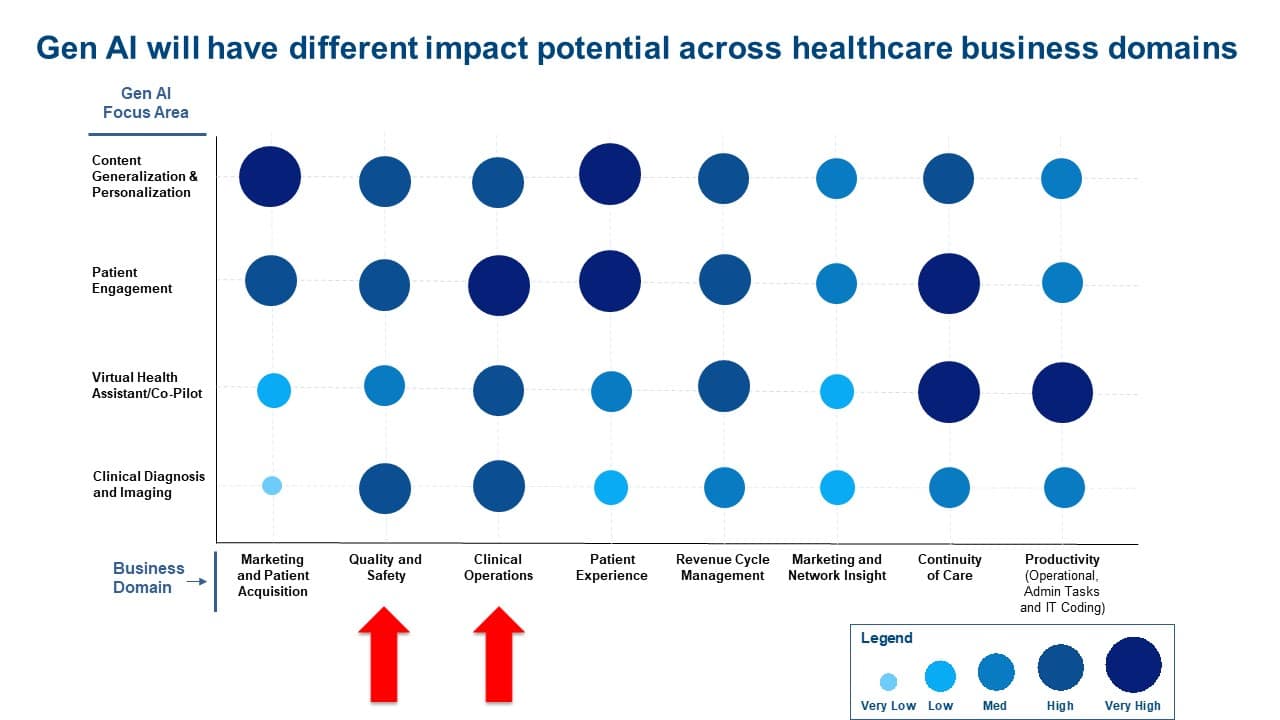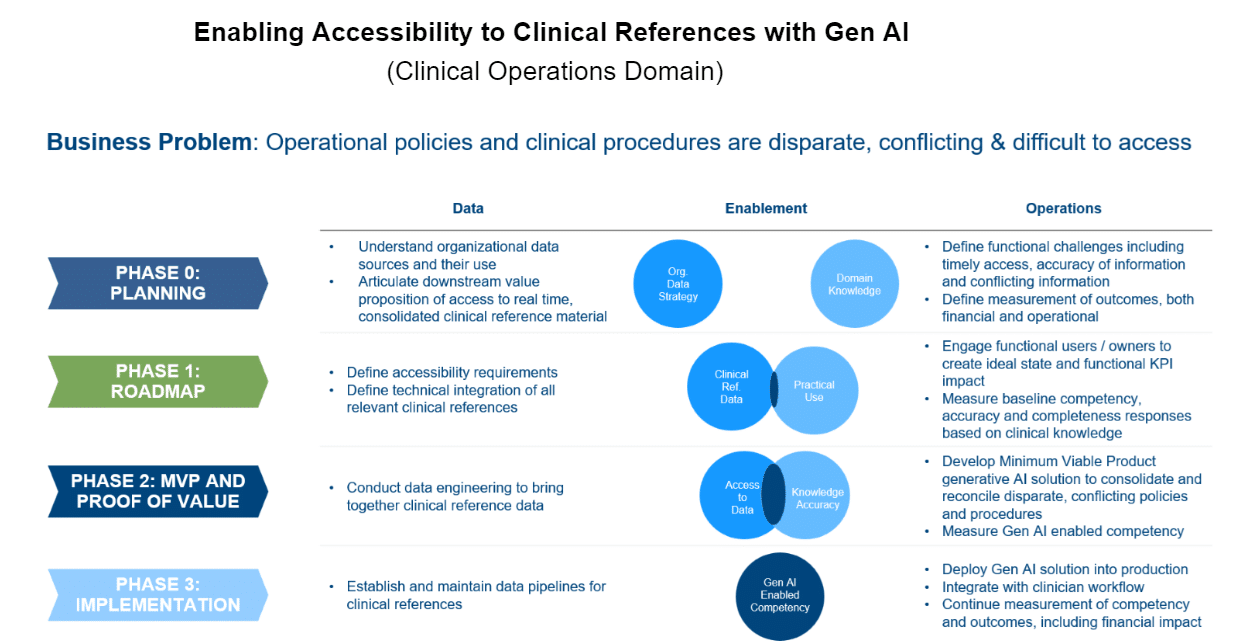Generative AI (Gen AI) is more than a technology; it is a key change agent to drive better patient engagement, clinical outcomes, and bottom-line financial impact. A recent Impact Advisors engagement with a leading academic health system underscores the importance of a business domain-based approach to achieving transformation. Gen AI success ultimately requires aligning business domains (such as patient experience or revenue cycle management) and adoption feasibility (i.e., whether the organization is ready for the change) to deliver the most value. Engaging key stakeholders throughout planning, development, and adoption processes and working with an experienced partner with a proven methodology for achieving measurable benefits from Gen AI solutions will rapidly deliver significant value.
What the Organization Achieved
Impact Advisors recently helped a leading academic health system embrace Gen AI as a change agent to drive targeted clinical and financial outcomes. The engagement followed a domain-based approach, specifically focusing on the Quality and Safety and Clinical Operations business domain.

Within the Quality and Safety domain, Impact Advisors developed a Central Line-Associated Bloodstream Infection (CLABSI) Large Language Model (LLM) to enable faster, more digestible, and consistent clinical summaries for infection preventionists to satisfy CMS quality reporting requirements. In the past, when a patient contracted a CLABSI, a significant amount of retrospective data needed to be gathered within the EHR – a cumbersome, highly time-intensive task. The academic health system clinicians can now prompt the LLM instead of manually abstracting the information. The necessary patient-specific data is readily available to fulfill defined quality criteria, the reporting is more accurate and less manual, and clinicians can spend more time with patients practicing at top-of-license.
Within the Clinical Operations domain, we developed a Clinical Reference LLM. The goal was to streamline access to a comprehensive source of current health system policies, procedures, protocols, and education materials. Clinicians can enter free text questions into the LLM about anything from dress code policies to hospital procedures for inserting a catheter and get rapid, accurate, and precise information (along with the source citations and documents for reference) in return.
How Impact Advisors Helped the Client
The planning, development, and implementation of both LLMs followed Impact Advisors’ rigorous methodology for helping clients define, measure, achieve, and sustain tangible value from Gen AI.
As one of the first steps, we designed a workshop with key clinical, operational, and IT leaders across the academic health system to help them define and identify possible use cases for Gen AI within each business domain. Participants assessed domains based on potential business value and adoption feasibility, ultimately landing on the Quality and Safety and the Clinical Operations domains.
Once the two target domains were identified, there were several critical steps to develop Gen AI “minimum viable products” (MVPs). This included identifying underlying use cases which would deliver the most value, understanding all of the current processes and data sources that would be impacted by the Gen AI MVPs, defining technical requirements, measuring baseline competency, and establishing ideal state key performance indicators (KPIs) for adoption and value capture. Once developed, the value of each Gen AI MVP also needed to be measured before being integrated into workflows. After implementation, we actively monitored KPIs to ensure clinicians had successfully adopted the solutions – and that business outcomes were changing as planned.
The figure below details how we specifically approached planning, developing, and implementing the Clinical Reference LLM within the Clinical Operations domain.

Why It Matters
1. Choose the domains that drive the most value for your hospital or health system.
Deciding which domains to target is not a trivial exercise. Each organization has its own unique culture, challenges, technical environment, and appetite for change. The domains and use cases selected need to reflect those realities. From the start, heavy involvement from key stakeholders is critical to ensure any Gen AI solutions will provide tangible value and garner widespread support and adoption across the health system.
2. Always keep a human in the loop.
Key stakeholders must be engaged throughout the entire lifecycle of developing a Gen AI solution, not just when selecting the domains and use cases. Significant participation must come from clinical, operational, and IT leaders as well as the end users who will be using the solution on a day-to-day basis. As the technical product is being developed, rapid, regular iterations with end users are critical to ensuring the Gen AI solution fits within their workflows and returns accurate and precise responses, free of drift and hallucinations.
3. Work with the right partner.
Given the expertise required and the level of effort involved, most hospitals and health systems will need to turn to a trusted partner to realize tangible value from Gen AI. The right partner should not only be forward-thinking, willing to experiment, and willing to invest – they should also have a proven, rigorous methodology for achieving value.
The Bottom Line
Gen AI cannot be viewed as just a technology or a tool. It is a change agent for clinical and financial transformation – and should be approached accordingly. Realizing the tangible, highly targeted outcomes possible from Gen AI requires a significant level of rigor around each facet of the process: from planning to building the strategic roadmap to developing an “MVP” and ultimately to industrialized implementation of the Gen AI solution. Choosing the domains that will drive the most value for your organization, engaging key stakeholders and end users during every phase of the project, and working with an experienced partner with a proven methodology for driving tangible value with Gen AI is critical.


